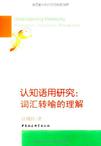认知语用研究
2009-5
中国社科
江晓红
201
20世纪80年代以来,乔治·莱考夫(Ceorge Lakoff),罗纳德·兰盖克(Ronald L,angacker)等著名语言学家开始系统地引入、传播认知语言学的基本思想,为深入探究隐喻、转喻等普遍语言现象的生成与理解提供了新视角、新的理论构架。此后,学者们不断尝试,并取得了丰硕的研究成果。进入21世纪以后,语言现象的认知研究日益呈现出一种势不可挡的发展态势,出现了很多与认知有关的新兴学科、界面研究,认知语法、认知语义学、认知语用学等的发展便是很好的例证。 转喻就是借用某物或某人的一个部分、一个因子去指代其整体,或整体代局部,已被普遍视为人类认识世界和传播意义的基本方式之一,也是人类思维方式的一种体现。然而,与隐喻相比,学者们对转喻的探索维度、深度及所取得的实际成果要少很多,这说明转喻研究还未得到充分重视,存在继续研究的必要性;同时也说明,转喻研究还存在很大的探索空间,如转喻与隐喻的界限、转喻激活、转喻联想与推理、转喻的认知功能、转喻生成的语境制约、转喻理解的认知机制与认知效果等还远未明晰,有待深入剖析,否则我们永远无法破解有关人类思维与认知的“黑洞”,也根本无法推进人工智能等信息处理的真正发展;另外,语言教学与学习、二语习得、翻译等也都难以回避语言使用中的转喻现象。总之,转喻及其相关问题的研究意义是多方面的、深层次的。
本书在吸收和融会语用学与认知语言学相关研究成果的基础上,以新颖、独特的视角,就汉语中的词汇转喻进行认知语用框架下的专题研究,探讨了转喻理解的制约因素、认知语用机制以及认知效果等问题,提供了在认知语言学和语用学之间寻求联系与统合的可能性,拓展了转喻研究的新思路。本书观点新颖、立意深刻、层次分明、引证翔实、语言流畅,具有较强的可读性和较高的学术参考价值。
江晓红,四川泸州人,广东肇庆学院副教授、博士。2008年毕业于广东外语外贸大学外国语言学及应用语言学专业,获文学博士学位。主要研究兴趣为语用学、认知语言学和应用语言学。近年来在各类学术期刊发表学术论文20余篇;出版专著l部,参编著作4部;曾参与教育部人文社科重点研究基地重大研究项目“词汇语用学——英、汉语言中词汇使用与理解”,目前正主持广东省哲学社会科学“十一五”规划项目“英汉词汇转喻的认知语用研究”。
Chapter One Introduction 1.1 The importance of metonymy in verbal communication 1.2 The target of research 1.3 Rationale of the research 1.4 Objectives of the study 1.5 Methodology for the research 1.6 Organization of the dissertation Chapter Two Review of the Relevant Literature 2.1 Introduction 2.2 Structuralist views 2.3 The perspective of cognitive semantics 2.3.1 Reference-point phenomena 2.3.2 The idealized cognitive model 2.3.3 Meaning elaboration 2.4 The pragmatic approach 2.4.1 Previous pragmatic accounts of metonymy 2.4.2 A preliminary relevance-theoretic account of metonymy 2.5 The limitations in current accounts of metonymyChapter Three A Description of the Conceptual Framework 3.1 Introduction 3.2 The delimitation of metonymy for the present study 3.2.1 Linguistic realization of metonymy 3.2.2 The working definition of metonymy 3.2.3 Distinguishing metonymy from metaphor 3.3 Theoretical foundations 3.3.1 Relevance theory 3.3.2 Cognitive semantics 3.3.3 The complementarity of cognitive semantics and relevance theory 3.4 The characterization of the conceptual framework 3.4.1 Constraints involved in metonymy recognition 3.4.2 Comprehension heuristics employed in metonymy interpretation 3.4.3 Cognitive effects achieved in metonymy interpretationChapter Four Constraints on Metonymy Recognition 4.1 Introduction 4.2 Syntactic constraint: syntactic deviations 4.3 Semantic constraint: violations of selection restrietion 4.4 Cognitive constraint: cognitive principles of relative salience 4.4.1 Human experience 4.4.2 Perceptual selectivity 4.4.3 Cultural preferences 4.5 Pragma-cognitive constraint: the constraining influence of context 4.5.1 Dynamic context 4.5.2 Mutual manifestness……Chapter Five Ad hoc Concept Construction of MetonymyChapter Six Cognitive Effects of Metonymy in Utterance InterpretationChapter Seven ConchusionBibliography后记
Although metonymic expressions are neither necessary nor sufficientfor the creation of genuine poetic effects, they are particularly well suitedto this purpose. As discussed above, some cases of metonymy are in-volved with an implicit and weak communication. What makes a met-onymic expression creative is that a single word or phrase triggers thediscovery of an array of implicatures. Metonymy often provides a compactform of an expression for complex ideas that cannot be explicitly speci-fied. This can by illustrated by an example such as the metonymic ex-pressions "a mandarin jacket" or "Western-style clothes" in (20) : Using the name of the judge who wore a mandarin jacket or West-ern-style clothes would have been simpler, but it would not have causedthe same results. The metonymic expressions are used to encourage amore extensive exploration of context and make more complex and moreprecise assumptions with regard to the actual situation and the state of af-fairs. In (20), the interpretation of metonymy requires some immediate-ly available encyclopedic knowledge attached to the metonymic expres-sions and some general knowledge derived from the striking contrast ofthe styles of clothes the two judges had on. Given that the context in-cludes the assumption about the circumstances, for example, the storytook place during the Revolution of 1911 in China, the extension of con-text finally results in a number of contextual implications, such as theradical and conservative attitudes toward the bourgeois democratic revo-lution held respectively by the two judges. Consider another famous po-em by Yu Guangzhong. ……
